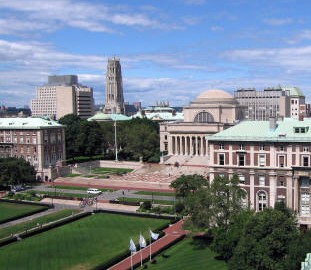Columbia University’s Core Curriculum
On Columbia University’s New York campus, an imposing statue of Alexander Hamilton stands at the entryway to Hamilton Hall, which houses the University’s main offices. This is fitting, because Hamilton is the school’s most revered alumnus.
A scholar, polymath, and prophet of the “novus ordo seclorem,” Hamilton accomplished much in his brief lifetime – army officer, statesman, indispensable contributor to the Constitution, and founder of the new nation’s financial system. Among the most effectual of the founders but one of the least appreciated historically, Hamilton’s star is waxing, not only in Hamilton on Broadway but in an excellent biography by Ron Chernow that has been at #1 on the New York Times bestseller list for over a year.
Hamilton attended King’s College, located at Trinity Church on Wall Street. Founded in 1754, King’s was the only college in America founded by a royal charter from King George II. The school possessed the many superb qualities that such an honorific would imply when Hamilton matriculated there in 1774.
Hamilton might still recognize aspects of the original educational philosophy of the College, renamed Columbia in 1784, in its practices today. The academic history and traditions of Columbia College are based in the classical forms of the English Enlightenment. In this mold, the College’s famous Core Curriculum evolved and grew until it was officially codified in 1919.
Columbia continues to be renowned for its rigorous Core Curriculum. The Core is a series of mandatory classes that form the foundation of the academic experience of every Columbia undergraduate. The following summary of the Core Curriculum and the philosophy behind it is provided on the Core’s main web page:
“The Core Curriculum is the set of common courses required of all undergraduates and considered the necessary general education for students, irrespective of their choice in major. The communal learning–with all students encountering the same texts and issues at the same time–and the critical dialogue experienced in small seminars are the distinctive features of the Core. The Core Curriculum is one of the founding experiments in liberal higher education in the United States. Not only academically rigorous but also personally transformative for students, the Core seminar thrives on oral debate of the most difficult questions about human experience. What does it mean, and what has it meant to be an individual? What does it mean, and what has it meant to be part of a community? How is human experience relayed and how is meaning made in music and art? What do we think is, and what have we thought to be worth knowing? By what rules should we be governed? The habits of mind developed in the Core cultivate a critical and creative intellectual capacity that students employ long after college, in the pursuit and the fulfillment of meaningful lives.”
The seminars and other requirements of the Core Curriculum are listed below along with the number of required semesters:
- Literature Humanities (2) – A seminar surveying the great works of Western literature, taken in freshman year.
- Contemporary Civilization (2) – A seminar surveying the great works of Western philosophy, religion, political theory, and economics, taken in sophomore year.
- Art Humanities (1) – A seminar surveying the great works of Western art.
- Music Humanities (1) – A seminar surveying the great works of Western music.
- University Writing (1) – A seminar designed to inculcate university-level writing skills, taken in freshman year.
- Foreign Language (4) – A distribution requirement intended to instill at least an intermediate skill level in foreign language.
- Frontiers of Science (1) – A lecture and seminar course designed to instill scientific habits of mind, taken in freshman year.
- Science Core (2) – A distribution requirement over any scientific disciplines.
- Global Core (2) – A distribution requirement meant to complement the Core classes that concentrate on Western civilization.
As you can see from the requirements, Columbia creates an environment in which all students form a foundation in the humanities in the great tradition of liberal arts education. The curriculum is as far from a highly specialized, vocation-oriented, postsecondary education as you can get. Of course, the non-Core portion of a student’s four-year curriculum, and the majority of their total credits toward graduation, is in classes that lead to a degree in their chosen major.
Although Columbia students, faculty, and administrators sing its praises, many prospective students shy away from the rigidity inherent in a curriculum with so many required courses, at least some of which may be in subjects that the student doesn’t particularly like. What most prospective students fail to notice about the Core is that it’s a shared undertaking. Commonality of experience lies at the heart of the Core’s academic value. The Core also develops outstanding analytical skills and a facility with the English language, both of which are advantageous in any career.
Columbia’s Core Curriculum is not for everyone, but for those students who love the in-depth, small-class seminars in the humanities, especially the classics reading list and the masterpieces of Western art and music, Columbia’s Core is among the best liberal arts programs in the English-speaking world.
IvySelect, a private college admissions consulting firm, has successfully assisted many students who were attracted to the Core Curriculum and gained admission to Columbia. For these students, IvySelect has provided expert guidance during all stages of the admissions process and especially in the development of the best possible application.
Our success in obtaining admission for our students to elite institutions extends to all of the Ivies — Harvard, Yale, Penn, Dartmouth, Princeton, Columbia, Cornell, and Princeton, as well as many other elite institutions including Stanford, MIT, Cal Tech, Amherst, Williams, Swarthmore, Northwestern, Chicago, Oxford (U.K.), Johns Hopkins, Duke, Colgate, Washington University – St. Louis, Georgetown, Emory, Bowdoin, Hamilton, Berkeley, UCLA, NYU, Wesleyan, Wellesley, Vassar, Barnard, Vanderbilt, Virginia, Michigan, Texas, North Carolina, and many others.





